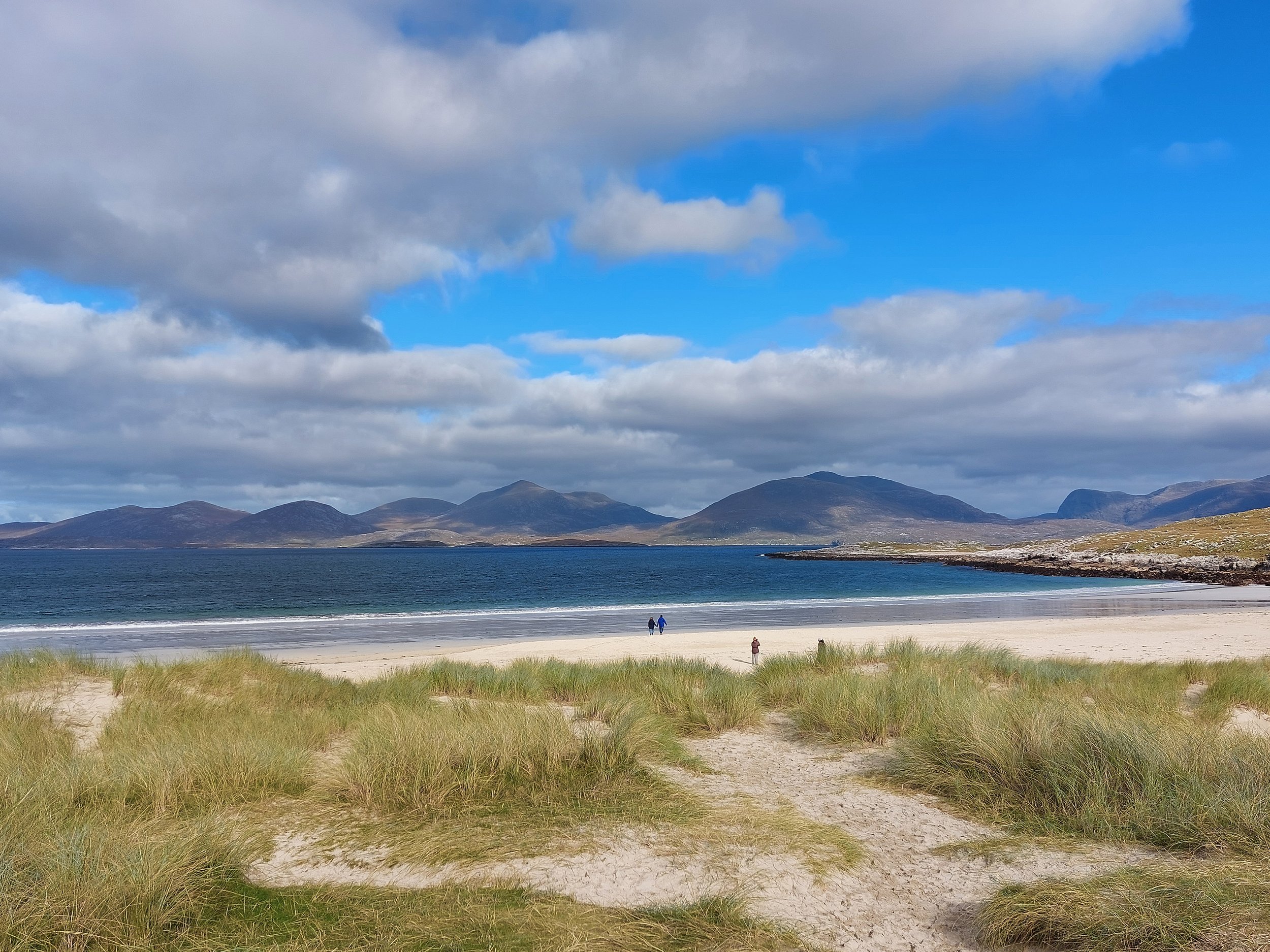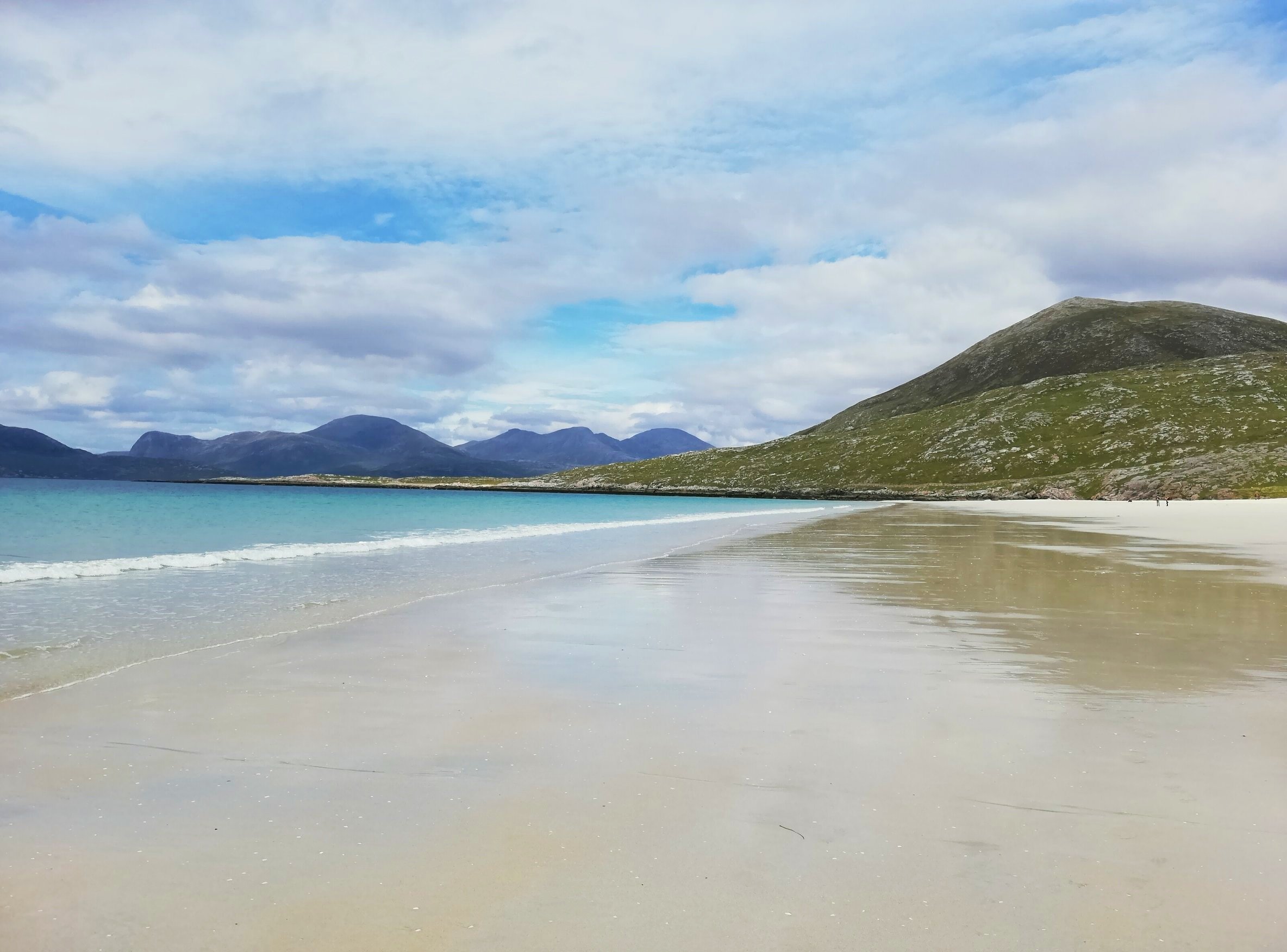Paradise Lost?
Susan Brown | Eyes on Scotland
There are always new phrases making their way into our language, and one of the latest popping up in the travel industry is “sustainable tourism.” So what is sustainable tourism? Well, it’s just about reducing the amount you travel and offsetting your emissions, isn’t it? A reaction to “over-tourism.”
Until last week, I understood over-tourism to be an urban problem, limited to cities like Edinburgh, Rome, Paris, New York, Sydney, or Barcelona. I was forced to re-evaluate in the most unlikely of locations—a beautiful beach on the Outer Hebrides of Scotland, about as far away from the likes of a global metropolis as you could possibly imagine. I was on a week-long trip to the Isles of Lewis and Harris to do some research for a small group tour I’ll be leading there in September 2022.
When people in my tour groups ask me what my favourite part of Scotland is, my answer is always the same: the Outer Hebrides. I’ve visited multiple times now, and to be honest, when I want somewhere to escape from everyone and relax, this is the place. My last visit was in June 2019 when, with my partner, we travelled the island from east to west, north to south and even out to the archipelago of St Kilda—a double-designated UNESCO World Heritage Site. We had a fabulous time, good weather, and no sense of tourist numbers impacting our enjoyment of the locations.
All over the world, the last 18 months have been like no other. In the UK, where people were unsure about booking vacations abroad due to travel restrictions; an ever-changing traffic light system for access to countries; and other Covid considerations, large numbers of Brits have been booking UK “staycations.” The desirability of many locations, including the Outer Hebrides, has increased markedly due to eager travellers posting on Instagram, Facebook, and Twitter; not to mention the celebrity travel programmes on television. I can think of at least four documentaries about the islands that debuted during lockdown earlier this year.
We were staying in Stornoway on Lewis and had planned a day trip down to the Isle of Harris (called an Isle but the Isles of Lewis and Harris are actually one island). The highlight was to be a visit to my favourite beach in the whole world. Quite the designation, I admit, but to me this beach has a spiritual quality, and I was really looking forward to returning. As we came over the hill from Tarbert, I could see the golden sands begin to come into view ahead of us and the anticipation was building.
As we got further down the hill, I saw car after car taking the turn onto the single track, dead-end road. My heart began to sink. As we made our way along the single track I noticed a number of new houses—a sure sign that the area had become more popular in the last few years. As we edged closer to the car park at the end of the road, the postman was struggling to get out from the drive of each house on his rounds due to the volume of cars.
We reached the end of the road and my heart sank further: the car park was completely full with camper vans and cars. Even the adjacent cemetery car park was pretty much full with cars parked on grassed areas that should never have been parked on. As we arrived, a car left so we managed to get a space…but I felt very uneasy. Our space was in the cemetery car park, and there were already people visiting loved ones' graves. What if someone else wanted to visit a grave and couldn’t get parked ? I considered leaving straight away but realised that the space I left would quickly be taken by another visitor for “the beach,” so I resolved to have one last visit—a farewell visit. I would not be back unless it was in the depths of winter, when hopefully there would not be the same volume of tourists. I had no wish to be part of the problem that I was witnessing right in front of me.
As I wandered through the dunes to the beach, my emotions began to rise. There was a major clash between my memories and the reality of what was now happening to this amazing place. Why was I so emotional? Was it that I felt my sacred place had been spoilt? Maybe partially, but there weren’t that many people on the beach. It was the caravan of cars on this one small length of single track road and the carnage in the car park that had upset me more. I thought about those who live year-round along that road (and on the islands) and the effect on their lives. They have to cope with this huge influx of visitors and their vehicles; the inconvenience and extra time required by the postman; the community nurses and carers on house calls; and the disruption to locals going about their daily business.
I live in a tourist town in central Scotland, so I’m used to large numbers of tourists. But this was different somehow: it felt like more of an invasion of privacy for those who lived in this beautiful community. They hadn’t asked for this invasion, there wasn’t even a shop along the road where people could buy supplies, yet they are now having to deal with the consequences of appearing on a social media hit list.
I was so blown away by what I was experiencing that I recorded an emotional video and posted it to our Guide Collective group workspace. What a wonderful bunch of people to work with, all but two of whom I have never actually met in person. Their support and encouragement was heartwarming, and I thank them all for their kind words. We have been having discussions for months about what sustainable tourism means to us as tourist guides. It is such an intangible and personal subject that we are still working through our thoughts to come up with our approach as a group.
I recorded another video on the beach that I am thinking about posting on my own social media, but I’m not sure the time is right or if the content is appropriate as we’re always supposed to be happy and cheery on social media, aren’t we?
I’m still not sure what sustainable tourism looks like but I am starting to formulate some ideas which might be the subject of a future article. One thing is certain: I’ll be taking my tour group to a different Hebridean beach where the infrastructure can cope and where we can “tread lightly.”



If you have any thoughts on sustainable tourism, I’d love to hear them. Please post them in the comments below.
